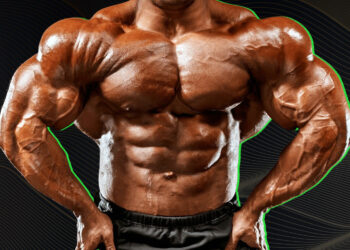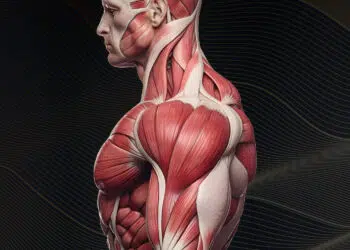Well-developed shoulders don’t happen by accident. That’s because the shoulders are a very complex joint made up of multiple large and small muscles. And yet, when it comes to shoulder training, most exercisers limit themselves to the same old overhead presses and lateral raises.
Such an imbalanced training approach can only build imbalanced shoulders that neither look nor function as well as they should.
In my experience, building picture-perfect 3D shoulders requires the right choice of exercises and intelligent programming. Get things wrong and you won’t be happy with the results, and could even end up with painful, injured shoulders.
As a veteran fitness writer and personal trainer, I spend a lot of my time designing workouts for articles and my clients. Consequently, I’m always excited when I get the chance to share a new exercise with my audience.
Needless to say, most “new” exercises are not actually new at all. Rather, they’re movements that are less well-known than the movements that most people build their programs around. While there is nothing wrong with these staple exercises, you can have too much of a good thing, and variety and change are often very welcome.
In this article, I explain how to do the victory raise – a movement that targets virtually every shoulder muscle and the perfect solution for anyone with achy joints or who is short on training time.
Level Up Your Fitness: Join our 💪 strong community in Fitness Volt Newsletter. Get daily inspiration, expert-backed workouts, nutrition tips, the latest in strength sports, and the support you need to reach your goals. Subscribe for free!
Victory Raise Correct Form and Video
There are two ways to do any exercise – the right way and the wrong way. The wrong way often lets you lift more weight or do more reps but, invariably, is also less effective and more likely to cause injury.
In contrast, the right way is usually stricter, which makes it harder, so you may have to lighten the load or do fewer reps. But, in return, you’ll keep the tension on the target muscles, which will make it safer and more effective.
So, long story short, always use the correct form!
Follow these step-by-step instructions to ensure that every rep of victory raises you perform is as productive and painless as possible.
- Stand with your feet roughly shoulder-width apart.
- Place a mini-band (a small loop-type resistance band) around your wrists.
- With your hands about hip-width apart, pick up a dumbbell in each hand so your palms face inward, i.e., a neutral grip.
- Brace your core and pull your shoulders down and back. Bend your elbows slightly but then keep them rigid for the duration of your set.
- Raise your arms forward and up so they form a V shape above your head. Make sure you push your hands out against the tension provided by the band. Keep the dumbbells neutral throughout – no twisting.
- Slowly return to the starting position with your hands just outside your hips. Do not release the tension from the band.
- Continue for the prescribed number of reps and set.
Victory Raise: Muscles Worked
Despite technically being an isolation shoulder exercise, victory raises work a surprisingly long list of muscles. This is part of what makes this exercise such an effective time-saver – it’s the only exercise you need for strong, balanced, muscular shoulders.
The main muscles developed by this awesome exercise are (1):
- Anterior deltoids
- Medial deltoids
- Posterior deltoids
- Upper trapezius
- Middle trapezius
- Lower trapezius
- Rhomboids
- Supraspinatus
- Infraspinatus
- Teres minor
- Subscapularis
Pro-Trainer Tips
Get more from victory raises with these tried-and-tested pro-trainer tips!
Use A Slow, Controlled Tempo
Keep the target muscles under constant tension by doing each rep slowly and with control. Take 2-3 seconds to raise your arms and another 2-3 seconds to lower them. Going faster will produce momentum, taking work away from your deltoids, trapezius, etc.
Go Light
This exercise won’t work if you use heavy weights. You must control the range of motion and the movement very precisely, which is impossible with hefty dumbbells.
The same rule applies to your mini-band. Use a light tension band so you can perform the exercise with strict form. Don’t worry – despite using light dumbbells and a weak band your shoulders will be on fire after a few reps.
High Reps and Short Rests Work Best
I usually program this exercise for 3-4 sets of 12-20 reps with 45-60 second inter-rest sets. This maximizes metabolic stress and deltoid pump, both of which contribute to hypotrophy or muscle growth. And yes, that burning you can feel in your shoulders is entirely normal!
Keep Your Shoulders Down and Back
It’s very tempting to allow your shoulders to rise up toward your ears during this exercise. That’s your body trying to help you lift the weights more easily. Unfortunately, this assistance makes the exercise less effective.
Keep your shoulders down by imagining you are trying to “put your shoulder blades in your back pockets.” The cue will help tidy up your form.
Victory Raise Mistakes to Avoid
Make victory raises as safe as possible by avoiding these common mistakes:
Using your legs or back to lift the weight – the victory raise is an isolation exercise, meaning only one joint should move. In this case, that’s the shoulders. Make sure you don’t let other muscles get in on the action, which will take work away from those you are trying to train. Do not use your legs or back to help you lift the weight.
Letting your hands come together – this exercise works best when you maintain constant outward tension on the mini-band. This keeps your muscles fully engaged during each rep. Press your hands outward even at the bottom of each rep to make victory raises as effective as possible.
Turning your arms or wrists – I often use the cue “lead with your thumbs” during this exercise. This helps my clients keep their hands in a neutral position, making the exercise both more comfortable and effective. Do not turn your hands or wrists inward as doing so will only impair your results.
Victory Raise Benefits
Not sure if victory raises deserve a place in your workouts? Consider these benefits and then decide.
Level Up Your Fitness: Join our 💪 strong community in Fitness Volt Newsletter. Get daily inspiration, expert-backed workouts, nutrition tips, the latest in strength sports, and the support you need to reach your goals. Subscribe for free!
More Time-Efficient Workouts
The victory raise works multiple shoulder muscles simultaneously. As such, you can use it in place of the overhead presses, front raises, lateral raises, bent-over flyes, and shrugs that most people include in their shoulder workouts. Doing one exercise instead of many is a much more efficient use of your training time.
Balanced Deltoid Development
If there was an award for the most hard-working upper body muscle, it should go to the anterior deltoid. Located at the front of your shoulder, the anterior deltoid is involved in every pressing exercise you do. As such, it’s often overdeveloped compared to the other deltoids – medial (side) and posterior (rear).
The good news is that victory raises work all three deltoids with a notable emphasis on the medial and posterior heads. As such, it’s a great exercise for developing balanced shoulders.
Better Posture
The victory raise is a great shoulder strengthener but it’s also a posture exercise in disguise. In addition to your deltoids, this movement works your mid and lower traps and your rhomboids. These muscles help control your shoulder girdle, which comprises your scapulae and clavicles. As such, the victory raise is an effective way to fix your desk slouch.
Less Joint Stress
A lot of lifters experience shoulder pain during overhead presses. Lack of thoracic spine mobility and certain anatomical deficiencies mean that full shoulder extension causes discomfort and, in some cases, severe pain. Using heavy weights doesn’t help, either.
As someone who suffers from chronic shoulder pain, I’m happy to report that victory raises are much more joint-friendly than almost every type of pressing exercise. I feel this exercise in my muscles, but never my shoulder joints.
Stronger Rotator Cuffs
The rotator cuff is a group of four small muscles (supraspinatus, infraspinatus, teres minor, subscapularis) located beneath your larger, outer deltoids. Together, they control and stabilize your shoulders. Weak rotator cuffs are a leading cause of shoulder instability, injury, and pain.
Victory raises provide your rotator cuff with a great workout, saving you from working these muscles separately.
Ideal for home Workouts
The victory raise is the perfect shoulder exercise for home workouts. All you need is a pair of light dumbbells and a cheap mini-band and you’re good to go. No mini-band? Use a booty band. You can even do this exercise with a belt around your wrists. This all proves that you don’t need a gym full of state of state-of-the-art exercise equipment to build muscle and strength.
Programming the Victory Raise
As I mentioned earlier, the victory raise works best when done for 3-4 sets of 12-20 reps with 45-60 second inter-rest sets. But where should you put it in your workouts? I have a few suggestions!
At the start of your shoulder workout – use this exercise to warm up and pre-fatigue your shoulders before moving on to the rest of your program. Pre-fatiguing your shoulders means you won’t be able (or need) to lift as much weight as usual, making your workout easier on your joints.
As your only shoulder exercise – short on time or low on energy but still want to train your shoulders? Replace your usual shoulder routine with a few sets of victory raises. This exercise is the all-in-one solution to your shoulder training needs.
At the end of your shoulder workout – I like to include finishers at the end of my workouts. They help to make sure that I’ve fully exhausted the target muscles. A couple of high-rep sets of victory raises will ensure you’ve left no shoulder muscle fiber left unstimulated.
Experiment with these three programming options to see which one you prefer.
Victory Raise Alternatives
While I’m a massive fan of victory raises, I also understand that even the best exercises can become boring and less effective if you do them too often. So, to that end, here are three alternatives that provide similar benefits.
Cable Y Raise
Like victory raises, the cable Y raise targets all three deltoid heads as well as your mid and lower traps and rhomboids. Also, like most cable movements, this exercise keeps your muscles under near-constant tension, making it an effective muscle builder. However, you will need an adjustable dual cable machine to do it.
Incline Y Raise
The incline Y raise works your posterior deltoids, mid and lower traps, and rhomboids. So, while it’s not quite as all-encompassing as victory raises, it’s still a good way to target the muscles that are often missing from most people’s shoulder workouts. Also, like victory raises, this is a very useful posture exercise.
Cable Face Pull with External Rotation
Conventional face pulls are one of my favorite rear deltoid/upper back exercises, but this lesser-known variation might be even better. Externally rotating your arms at the top of each rep strengthens your rotator cuffs to make your shoulders more stable, healthy, and resilient.
Victory Raise Closing Thoughts
“Go heavy or go home” is a bodybuilding mantra, and a lot of lifters think that anything other than heavy training is a waste of time. After all, get two bodybuilders together and they’re bound to start comparing workout poundages.
However, big weights are not the only way to build muscle and strength. In many cases, lighter weights and more challenging movements can be just as effective.
Take the victory raise, for example; the combination of light dumbbells, a mini-band, and a large range of motion will set your shoulders on fire. This exercise looks easy but, in reality, it’s anything but.
My clients and I love the victory raise, and it’s a staple of our shoulder workouts. So, give it a try – I think you’ll love it too!
References:
- Elzanie A, Varacallo M. Anatomy, Shoulder and Upper Limb, Deltoid Muscle. [Updated 2024 Jan 30]. In: StatPearls [Internet]. Treasure Island (FL): StatPearls Publishing; 2024 Jan-. Available from: https://www.ncbi.nlm.nih.gov/books/NBK537056/
Interested in measuring your progress? Check out our strength standards for Face Pull.








